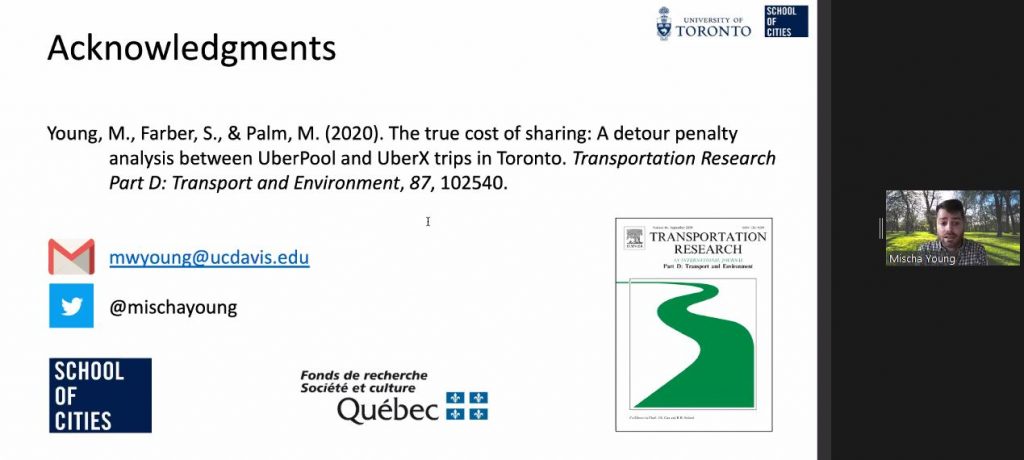
Dr. Mischa Young presented “The true cost of sharing: A detour penalty analysis between UberPool and UberX trips in Toronto” as part of the School of Cities Urban Leadership Fellowship and Academy Virtual Research Festival, Session 3, on September 25.
Young, who recently earned his PhD in Urban Planning at University of Toronto under the supervision of UTTRI associated faculty Professor Steven Farber, is now a postdoctoral research fellow at University of California, Davis.
The talk abstract states: “Pooled ride-hailing services such as UberPool are believed to contribute towards reducing greenhouse gas emissions and traffic congestion, and have caught the eye of policymakers as they align much closer to sustainable transport objectives. However, the relative sustainability of these services depends on their ability to successfully match riders for pooled trips. In this presentation, I examine the matching propensity of shared ride-hailing services and explore the detour time penalty associated with pooling, as this impacts the uptake and viability of shared services.”
Young says that in summary, while 15% of ridehailing trips in Toronto are pooled, only 52% of these are actually matched. He states that on average, pooled trips takes 3.6 minutes longer than comparable non-shared trips, and that unless efforts are made to promote shared ridehailing, it is unlikely to be as transformative as promised.

This research was published as “The true cost of sharing: A detour penalty analysis between UberPool and UberX trips in Toronto,” by Mischa Young, Steven Farber, and Matthew Palm in Transportation Research Part D: Transport and Environment, Vol. 87, October 2020.

Mischa Young is a postdoctoral research fellow at the University of California, Davis’s Institute of Transportation Studies (ITS-Davis). His research focuses on emerging transportation technologies and the future of personal mobility. Lately, his research has centred on the impacts of ride-hailing services (e.g. Uber and Lyft) and on the regulatory policies surrounding this new travel mode. Beyond researching how to leverage new mobility technologies to design more equitable and sustainable cities, he is also an avid cyclist and an urban tree enthusiast.
